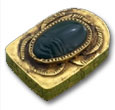
A scarab is a dung beetle belonging to the Scarabaeidae family. They are scavengers that feed on dung and other decaying organic matter, playing a valuable role in keeping the veld (area of open grass) clean. They vary in size from small to large with stout bodies. Their front legs are very powerful with teeth on the outer edge. Many dung beetles, known as rollers, are noted for rolling dung into spherical balls, which are used as a food source or brooding chambers.
The Egyptians revered them as a symbol of Spontaneous Generation, New Life, and Resurrection. Early in Egyptian history the beetle also came to represent the soul rising from death – resurrected, transcendent, fully formed and ready to make its journey and face its judgment in order to live in the Afterlife. By the New Kingdom (1539-1070 BC), the funerary texts from the papyri portray a scaraboid form as the most powerful symbol of life’s victory over death.
One of the many images of the sun god Ra was the scarab beetle or Khepri. The ancient Egyptians believed that Khepri renewed the sun every day before rolling it above the horizon, then carried it through the other world after sunset, only to renew it, again, the next day. They also noticed that small beetles emerged from similar balls and assumed that, like the sun the scarab was a self-created entity. The opening and closing of the scarab’s colorful wings symbolized night and day.
The Egyptians also used the Scarab for recording historical events and as seals by officials. They were also worn as jewelry and used as amulets in ancient Egypt. The heart scarab containing hieroglyphic inscriptions on the back was of prime significance in the funerary cult of ancient Egypt.
Theories Behind the Heart Scarab and Burial Rites
An amulet was placed on the chest of the mummy to ensure that the heart, believed to be the seat of intelligence and personality, was not removed. A verse of Spell 30B of the Book of the Dead is roughly incised around the base of the scarab.
They were buried with the dead to ensure the rebirth of the deceased in the afterlife. They were placed over the heart of the deceased to keep them from confessing sins during its interrogation in the “Weighing of the Heart” ceremony.
The Egyptians feared that the heart, the seat of memory and conscience, would testify against the deceased at the Divine Tribunal. Placing a heart scarab in the mummy bandages or around the neck of the deceased was designed to prevent this. They are often inscribed with a spell from the Book of the Dead imploring the heart not to abandon its owner.
Scarabs could be made from a variety of materials. The earliest heart scarab known was made of green jasper. Most scarabs were made of Steatite and then covered with a turquoise colored glaze. The glazing made the stone hard and durable.
Other materials used are: limestone, carnelian, schist, lapis, lazuli, turquoise, ivory, bronze, and resin. Some were made of gold and silver, but they are very rare. Later the Greeks make scarabs with other materials such as onyx, agate, and quartz.










